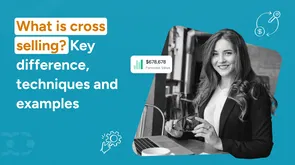Businesses are always looking for ways to streamline their sales process and make the most of their leads. A well-designed automated sales funnel helps guide potential customers from awareness to conversion without requiring constant manual effort.
Automated sales funnels significantly improve the efficiency of marketing campaigns by increasing conversion rates, enhancing efficiency, boosting engagement, and providing data-driven insights.
This guide walks you through the essential steps to build a high-performing automated sales funnel that keeps customers engaged and boosts sales.
What is an automated sales funnel?
An automated sales funnel is a structured process that guides potential customers through the buying journey—from awareness to conversion—without requiring manual intervention at every step.
Sales funnel automation leverages technology to streamline the customer journey, using tools like AI to nurture leads, personalize outreach, and optimize follow-ups, ultimately increasing efficiency and revenue.
Why every business needs a sales funnel
A well-defined sales funnel is crucial for businesses to:
- Consistently generate leads: A structured funnel attracts potential customers and moves them through the customer journey efficiently.
- Increase conversions: By nurturing leads at different stages, an automated funnel boosts the chances of closing deals.
- Save time and effort: Automation eliminates repetitive tasks like follow-ups, email marketing, and lead tracking.
- Optimize marketing strategies: Businesses can track funnel performance and tweak strategies to enhance results.
- Enhance sales team efficiency: Automated sales funnels allow sales teams to handle a larger volume of leads without needing to expand their size, boosting conversion rates and overall effectiveness.
How automation enhances the sales process
Sales funnel automation streamlines customer acquisition and engagement by:
- Automating lead nurturing: Email sequences and CRM follow-ups keep leads engaged.
- Delivering personalized experiences: AI-driven insights help tailor content and offers based on customer behavior.
- Reducing response time: Automated workflows ensure prospects receive timely responses, increasing engagement.
- Boosting sales team efficiency: Sales reps can focus on closing deals while automation handles routine tasks.
Benefits of an automated sales funnel
An automated sales funnel transforms how businesses interact with potential customers, ensuring a smoother and more efficient buying process. Here’s why automating your sales funnel is a game-changer:
Marketing automation plays a crucial role in optimizing sales and lead generation processes.
1. Time efficiency
Sales automation eliminates the need for manual follow-ups, repetitive tasks, and administrative work. This allows the sales team to focus on closing deals and building relationships rather than spending time on data entry and manual outreach.
2. Personalized customer journeys
Automation enables businesses to customize messaging, offers, and follow-ups based on a customer's journey, educating and engaging customers at each step according to their behavior, preferences, and interactions.
By segmenting your audience and tailoring content accordingly, you increase engagement and the likelihood of conversions.
3. Higher conversion rates
With an automated approach, leads receive timely nurturing through email sequences, chatbots, and retargeting campaigns.
Automated reminders and follow-ups ensure that no potential customer slips through the cracks, boosting conversion rates significantly by transforming leads into paying customers.
4. Data-driven decision making
An automated sales funnel provides actionable insights by tracking customer interactions, engagement metrics, and conversion rates.
With marketing automation software, businesses can analyze funnel performance and make data-backed decisions to optimize marketing efforts.
5. Cost savings & scalability
By automating repetitive sales processes, companies save money on labor and operational costs while maximizing productivity.
Utilizing a marketing automation platform also makes it easier to scale operations, handling large volumes of leads and customers without increasing manual workload.
6. Consistent lead nurturing & engagement
Automated sequences using a marketing automation tool keep leads engaged with your brand, ensuring consistent communication at each stage of the funnel.
This prevents leads from going cold and builds long-term relationships with potential customers.
7. Seamless integration with sales & marketing
Modern automation tools integrate seamlessly with CRMs, email platforms, chat widgets, and other marketing channels.
By leveraging a marketing automation funnel, businesses can capture new leads and guide them through the awareness stage, nurturing them with personalized experiences.
8. Better customer retention
Post-purchase engagement with a paying customer is crucial for repeat business. Automated funnels can include follow-up emails, loyalty programs, and personalized recommendations to enhance customer experience and encourage brand loyalty.
By leveraging these benefits, businesses can create a high-converting, cost-effective, and scalable sales funnel that delivers results consistently.
Pre-funnel setup
Conducting market research
Before diving into the creation of an automated sales funnel, it’s crucial to conduct thorough market research.
This step is foundational, as it provides the insights needed to tailor your sales process to the specific needs and pain points of your potential customers.
Effective market research helps you understand who your audience is, what they need, and how you can best serve them.
To gather this valuable data, consider using a variety of methods:
Surveys and Questionnaires: Directly ask your audience about their preferences, challenges, and needs.
Focus Groups and Interviews: Engage in deeper conversations to gain nuanced insights.
Online Analytics Tools: Utilize tools like Google Analytics to track user behavior and gather demographic data.
Social Media Listening: Monitor social media platforms to understand what your audience is talking about and what issues they are facing.
By conducting comprehensive market research, you can create a sales funnel that is not only effective but also highly relevant to your target audience. This ensures that your marketing efforts are aligned with the expectations and needs of your potential customers, setting the stage for higher engagement and conversion rates.
Automate your sales funnel & close more deals
Reduce manual tasks, nurture leads effectively, and scale your sales with Salesmate’s automation. Try it free today!
Creating a unique offer
Once you have a clear understanding of your target audience through market research, the next step is to create a unique offer that stands out.
Your offer should address the specific needs and pain points of your potential customers, providing them with a compelling reason to engage with your brand and move through your sales funnel.
Here are the steps to create a unique offer:
- Identify needs and pain points: Use the insights from your market research to pinpoint what your audience is looking for.
- Develop a solution: Create a product or service that directly addresses these needs and pain points.
- Craft a clear value proposition: Clearly articulate the benefits of your offer and how it solves your audience’s problems.
- Develop a unique selling proposition (USP): Highlight what makes your offer different from competitors. This could be a unique feature, superior quality, or exceptional customer service.
By creating a unique offer that resonates with your potential customers, you can effectively guide them through the sales process, increasing the likelihood of conversion and building a strong foundation for your automated sales funnel.
The stages of a sales funnel
A well-structured sales funnel consists of several key stages that guide potential customers from initial awareness to becoming loyal customers. Understanding these stages helps in crafting a more effective automated sales process:
1. Awareness
At this stage, potential customers discover your business through channels such as SEO, social media, paid ads, or word-of-mouth. The goal is to capture their attention and introduce them to your brand.
Strategies for this stage:
- Content marketing (blog posts, videos, infographics)
- Social media marketing
- Paid advertising
- Webinars and educational content
2. Interest
Once people are aware of your brand, they start showing interest by engaging with your content, visiting your website, or subscribing to your newsletter.
Strategies for this stage:
- Lead magnets (free eBooks, checklists, templates)
- Email marketing campaigns
- Retargeting ads
- Product demonstrations or free trials
3. Consideration
In this phase, potential customers evaluate your offerings and compare them with competitors. They may read reviews, check out case studies, or ask for recommendations.
Strategies for this stage:
- Customer testimonials and reviews
- Case studies and success stories
- Free consultations or demos
- Detailed product/service comparisons
4. Decision
The prospect is now ready to make a purchase decision. Your goal is to remove any remaining doubts and provide a seamless buying experience.
Strategies for this stage:
- Clear and compelling call-to-action (CTA)
- Limited-time offers or discounts
- Personalized email follow-ups
- Live chat or sales call support
5. Retention & loyalty
After the purchase, retaining customers and building long-term relationships is crucial for business growth.
Strategies for this stage:
- Onboarding emails and user guides
- Exclusive loyalty programs and rewards
- Upselling and cross-selling opportunities
- Personalized customer support
By aligning your automated sales funnel with these stages, you can create a seamless experience that converts leads into loyal customers while optimizing your sales efforts.
Step-by-step guide to creating an automated sales funnel
1. Identify your target audience
To build an effective sales funnel, start by understanding your audience to create automated sales funnels and an automated sales process:
- Who are they?
- What problems are they facing?
- What solutions do they need?
Use customer data from your CRM or website analytics to create buyer personas. Platforms like Salesmate provide valuable insights into customer behaviors, helping you fine-tune your sales funnel for different audience segments.
2. Drive targeted traffic
Without traffic, your sales funnel has no leads to convert. The most effective traffic sources include:
- SEO and content marketing: Writing blogs, guides, and case studies.
- Paid advertising: Running PPC campaigns on Google Ads or social media.
- Social media marketing: Engaging audiences through LinkedIn, Facebook, and Instagram.
- Referral and affiliate marketing: Partnering with influencers or affiliates to drive leads.
3. Create a lead magnet
A lead magnet is a free resource offered in exchange for an email or contact information. High-performing lead magnets include:
- Free eBooks, checklists, or templates
- Exclusive webinars or case studies
- Free trials or discounts
- Interactive quizzes or assessments
Use landing pages optimized for conversion to deliver lead magnets efficiently. Salesmate’s Forms and Chat Widgets can help capture leads directly from your website.
4. Build a high-converting landing page
A compelling landing page should have:
- A clear headline that states the benefit
- A short description explaining the offer
- A prominent CTA (Call to Action)
- Minimal form fields to reduce friction
- Social proof (testimonials, reviews, logos)
5. Automate lead nurturing with email sequences
Once leads enter your funnel, automated email sequences help nurture them towards conversion. Key email types include:
- Welcome emails: Introduce your brand and set expectations.
- Educational emails: Provide value with insightful content.
- Follow-up emails: Gently push leads to the next stage.
- Cart abandonment emails: Remind prospects about pending actions.
- Testimonial emails: Build trust through social proof.
Salesmate’s Email Automation allows you to set up personalized, behavior-triggered email sequences, ensuring that leads receive the right message at the right time.
6. Implement lead scoring
Not all leads are ready to buy. Lead scoring helps prioritize them based on engagement levels. Assign points for:
- Email opens and clicks
- Website visits and time spent on key pages
- Webinar attendance or content downloads
Salesmate’s Smart Workflow Automation can tag and segment leads automatically based on engagement metrics.
7. Personalize the customer journey
Modern buyers expect tailored experiences. Use behavior-based automation to deliver:
- Dynamic content based on past interactions
- Personalized product recommendations
- Retargeting ads tailored to specific funnel stages
8. Optimize the checkout and sales process
For eCommerce and service-based businesses, the checkout process should be seamless. To increase conversions:
- Reduce form fields and checkout steps
- Offer multiple payment options
- Add urgency (limited-time offers, countdown timers)
- Provide live chat support for last-minute questions
9. Retain customers with post-sale engagement
The sales funnel doesn’t end after purchase. Customer retention strategies include:
- Onboarding emails with usage guides
- Exclusive loyalty discounts and rewards
- Upselling and cross-selling campaigns
- Personalized follow-ups and check-ins
Automation ensures that no customer is forgotten, keeping them engaged and increasing their lifetime value.
Common mistakes to avoid in sales funnel automation
Ignoring customer segmentation
Failing to segment your leads properly can result in irrelevant messaging, leading to poor engagement and lower conversion rates. Utilize segmentation based on demographics, behavior, and lead score to ensure targeted communication.
Overcomplicating the funnel stages
A sales funnel should be simple and intuitive. Too many steps, excessive CTAs, or unnecessary emails can confuse prospects and lead to drop-offs. Keep the funnel streamlined and focus on key conversion points.
Lack of personalization in automation
Automation doesn’t mean losing the human touch. Failing to personalize emails, offers, or follow-ups can make your messages feel robotic. Use CRM insights to craft engaging, personalized content that resonates with your audience.
Streamline Your Sales Process with a Proven Framework
Use our Sales Pipeline Template to track deals, manage leads, and optimize your sales funnel for better conversions.
3 Marketing automation tips for a successful automated sales funnel
A well-structured automated sales funnel is only effective if you use the right marketing automation techniques. Here are three essential marketing automation tips to boost your sales funnel’s performance:
1. Leverage behavioral triggers
Use automation to track user behavior and trigger personalized responses. For example:
- Send a follow-up email when a lead downloads a resource.
- Offer discounts if a visitor abandons their cart.
- Use dynamic content based on past interactions.
2. Optimize lead segmentation
Not all leads are the same, so segment them based on:
- Demographics (industry, location, company size)
- Behavior (email engagement, website visits, purchase history)
- Sales stage (cold lead, warm lead, ready-to-buy prospect)
Segmenting leads ensures they receive relevant and effective messaging.
3. Automate multi-channel engagement
Relying only on email automation limits your reach. Instead, integrate multiple communication channels like:
- SMS reminders for high-intent leads.
- AI-powered chatbots for instant support.
- Retargeting ads to re-engage inactive leads.
By implementing these marketing automation strategies, businesses can ensure their automated sales funnels are effective, personalized, and conversion-driven.
Salesmate: Automate your sales funnel with ease
Salesmate simplifies sales funnel automation with powerful features that save time and boost conversions.
- Smart workflow automation – Automate follow-ups, lead assignments, and pipeline tracking effortlessly.
- AI-Powered email sequences – Set up automated email campaigns to nurture and convert leads efficiently.
- Marketing automation – Deliver personalized content based on customer behavior for better engagement.
- Sales pipeline management – Get real-time visibility into deals and track progress with ease.
- Multi-channel engagement – Connect with leads via email, SMS, WhatsApp, live chat, and calls.
- Lead scoring & smart segmentation – Prioritize high-intent leads based on engagement.
- Real-time analytics & reports – Track conversions, optimize strategies, and improve performance.
Conclusion
An automated sales funnel is essential for scaling your sales process efficiently. By leveraging CRM software like Salesmate, businesses can automate lead capture, nurture leads with personalized email sequences, and optimize their sales process with real-time data.
Start building your automated sales funnel today, and watch your sales process become more efficient, scalable, and conversion-driven.
Frequently asked questions
1) What is the difference between an automated and a manual sales funnel?
An automated sales funnel leverages tools like email automation, CRM integrations, and AI-driven triggers to guide leads through the buying journey. A manual funnel requires sales reps to track and nurture leads manually, which can be time-consuming and inconsistent.
2) What tools are needed to build an automated sales funnel?
To build an automated sales funnel, you need:
- CRM software to manage contacts and track engagement
- Email automation tools for personalized sequences
- Landing page builders to capture leads
- Analytics tools to measure performance
- Payment gateways for seamless transactions
3) How long does it take to set up an automated sales funnel?
The time required depends on the complexity of the funnel. A simple funnel (e.g., lead magnet → email sequence → offer) can be set up in a few days. More advanced funnels with multiple touchpoints may take several weeks to refine and optimize.
4) How do I know if my automated sales funnel is working?
Monitor key performance indicators (KPIs) such as:
- Conversion rates at each funnel stage
- Email open and click-through rates
- Customer acquisition cost (CAC)
- Customer lifetime value (CLV)
Reporting & Analytics provides deep insights into funnel performance, helping businesses make data-driven improvements.







Key Takeaways
Businesses are always looking for ways to streamline their sales process and make the most of their leads. A well-designed automated sales funnel helps guide potential customers from awareness to conversion without requiring constant manual effort.
Automated sales funnels significantly improve the efficiency of marketing campaigns by increasing conversion rates, enhancing efficiency, boosting engagement, and providing data-driven insights.
This guide walks you through the essential steps to build a high-performing automated sales funnel that keeps customers engaged and boosts sales.
What is an automated sales funnel?
An automated sales funnel is a structured process that guides potential customers through the buying journey—from awareness to conversion—without requiring manual intervention at every step.
Sales funnel automation leverages technology to streamline the customer journey, using tools like AI to nurture leads, personalize outreach, and optimize follow-ups, ultimately increasing efficiency and revenue.
Why every business needs a sales funnel
A well-defined sales funnel is crucial for businesses to:
How automation enhances the sales process
Sales funnel automation streamlines customer acquisition and engagement by:
Benefits of an automated sales funnel
An automated sales funnel transforms how businesses interact with potential customers, ensuring a smoother and more efficient buying process. Here’s why automating your sales funnel is a game-changer:
Marketing automation plays a crucial role in optimizing sales and lead generation processes.
1. Time efficiency
Sales automation eliminates the need for manual follow-ups, repetitive tasks, and administrative work. This allows the sales team to focus on closing deals and building relationships rather than spending time on data entry and manual outreach.
2. Personalized customer journeys
Automation enables businesses to customize messaging, offers, and follow-ups based on a customer's journey, educating and engaging customers at each step according to their behavior, preferences, and interactions.
By segmenting your audience and tailoring content accordingly, you increase engagement and the likelihood of conversions.
3. Higher conversion rates
With an automated approach, leads receive timely nurturing through email sequences, chatbots, and retargeting campaigns.
Automated reminders and follow-ups ensure that no potential customer slips through the cracks, boosting conversion rates significantly by transforming leads into paying customers.
4. Data-driven decision making
An automated sales funnel provides actionable insights by tracking customer interactions, engagement metrics, and conversion rates.
With marketing automation software, businesses can analyze funnel performance and make data-backed decisions to optimize marketing efforts.
5. Cost savings & scalability
By automating repetitive sales processes, companies save money on labor and operational costs while maximizing productivity.
Utilizing a marketing automation platform also makes it easier to scale operations, handling large volumes of leads and customers without increasing manual workload.
6. Consistent lead nurturing & engagement
Automated sequences using a marketing automation tool keep leads engaged with your brand, ensuring consistent communication at each stage of the funnel.
This prevents leads from going cold and builds long-term relationships with potential customers.
7. Seamless integration with sales & marketing
Modern automation tools integrate seamlessly with CRMs, email platforms, chat widgets, and other marketing channels.
By leveraging a marketing automation funnel, businesses can capture new leads and guide them through the awareness stage, nurturing them with personalized experiences.
8. Better customer retention
Post-purchase engagement with a paying customer is crucial for repeat business. Automated funnels can include follow-up emails, loyalty programs, and personalized recommendations to enhance customer experience and encourage brand loyalty.
By leveraging these benefits, businesses can create a high-converting, cost-effective, and scalable sales funnel that delivers results consistently.
Pre-funnel setup
Conducting market research
Before diving into the creation of an automated sales funnel, it’s crucial to conduct thorough market research.
This step is foundational, as it provides the insights needed to tailor your sales process to the specific needs and pain points of your potential customers.
Effective market research helps you understand who your audience is, what they need, and how you can best serve them.
To gather this valuable data, consider using a variety of methods:
Surveys and Questionnaires: Directly ask your audience about their preferences, challenges, and needs.
Focus Groups and Interviews: Engage in deeper conversations to gain nuanced insights.
Online Analytics Tools: Utilize tools like Google Analytics to track user behavior and gather demographic data.
Social Media Listening: Monitor social media platforms to understand what your audience is talking about and what issues they are facing.
By conducting comprehensive market research, you can create a sales funnel that is not only effective but also highly relevant to your target audience. This ensures that your marketing efforts are aligned with the expectations and needs of your potential customers, setting the stage for higher engagement and conversion rates.
Automate your sales funnel & close more deals
Reduce manual tasks, nurture leads effectively, and scale your sales with Salesmate’s automation. Try it free today!
Creating a unique offer
Once you have a clear understanding of your target audience through market research, the next step is to create a unique offer that stands out.
Your offer should address the specific needs and pain points of your potential customers, providing them with a compelling reason to engage with your brand and move through your sales funnel.
Here are the steps to create a unique offer:
By creating a unique offer that resonates with your potential customers, you can effectively guide them through the sales process, increasing the likelihood of conversion and building a strong foundation for your automated sales funnel.
The stages of a sales funnel
A well-structured sales funnel consists of several key stages that guide potential customers from initial awareness to becoming loyal customers. Understanding these stages helps in crafting a more effective automated sales process:
1. Awareness
At this stage, potential customers discover your business through channels such as SEO, social media, paid ads, or word-of-mouth. The goal is to capture their attention and introduce them to your brand.
Strategies for this stage:
2. Interest
Once people are aware of your brand, they start showing interest by engaging with your content, visiting your website, or subscribing to your newsletter.
Strategies for this stage:
3. Consideration
In this phase, potential customers evaluate your offerings and compare them with competitors. They may read reviews, check out case studies, or ask for recommendations.
Strategies for this stage:
4. Decision
The prospect is now ready to make a purchase decision. Your goal is to remove any remaining doubts and provide a seamless buying experience.
Strategies for this stage:
5. Retention & loyalty
After the purchase, retaining customers and building long-term relationships is crucial for business growth.
Strategies for this stage:
By aligning your automated sales funnel with these stages, you can create a seamless experience that converts leads into loyal customers while optimizing your sales efforts.
Step-by-step guide to creating an automated sales funnel
1. Identify your target audience
To build an effective sales funnel, start by understanding your audience to create automated sales funnels and an automated sales process:
Use customer data from your CRM or website analytics to create buyer personas. Platforms like Salesmate provide valuable insights into customer behaviors, helping you fine-tune your sales funnel for different audience segments.
2. Drive targeted traffic
Without traffic, your sales funnel has no leads to convert. The most effective traffic sources include:
3. Create a lead magnet
A lead magnet is a free resource offered in exchange for an email or contact information. High-performing lead magnets include:
Use landing pages optimized for conversion to deliver lead magnets efficiently. Salesmate’s Forms and Chat Widgets can help capture leads directly from your website.
4. Build a high-converting landing page
A compelling landing page should have:
5. Automate lead nurturing with email sequences
Once leads enter your funnel, automated email sequences help nurture them towards conversion. Key email types include:
Salesmate’s Email Automation allows you to set up personalized, behavior-triggered email sequences, ensuring that leads receive the right message at the right time.
6. Implement lead scoring
Not all leads are ready to buy. Lead scoring helps prioritize them based on engagement levels. Assign points for:
Salesmate’s Smart Workflow Automation can tag and segment leads automatically based on engagement metrics.
7. Personalize the customer journey
Modern buyers expect tailored experiences. Use behavior-based automation to deliver:
8. Optimize the checkout and sales process
For eCommerce and service-based businesses, the checkout process should be seamless. To increase conversions:
9. Retain customers with post-sale engagement
The sales funnel doesn’t end after purchase. Customer retention strategies include:
Automation ensures that no customer is forgotten, keeping them engaged and increasing their lifetime value.
Common mistakes to avoid in sales funnel automation
Ignoring customer segmentation
Failing to segment your leads properly can result in irrelevant messaging, leading to poor engagement and lower conversion rates. Utilize segmentation based on demographics, behavior, and lead score to ensure targeted communication.
Overcomplicating the funnel stages
A sales funnel should be simple and intuitive. Too many steps, excessive CTAs, or unnecessary emails can confuse prospects and lead to drop-offs. Keep the funnel streamlined and focus on key conversion points.
Lack of personalization in automation
Automation doesn’t mean losing the human touch. Failing to personalize emails, offers, or follow-ups can make your messages feel robotic. Use CRM insights to craft engaging, personalized content that resonates with your audience.
Streamline Your Sales Process with a Proven Framework
Use our Sales Pipeline Template to track deals, manage leads, and optimize your sales funnel for better conversions.
3 Marketing automation tips for a successful automated sales funnel
A well-structured automated sales funnel is only effective if you use the right marketing automation techniques. Here are three essential marketing automation tips to boost your sales funnel’s performance:
1. Leverage behavioral triggers
Use automation to track user behavior and trigger personalized responses. For example:
2. Optimize lead segmentation
Not all leads are the same, so segment them based on:
Segmenting leads ensures they receive relevant and effective messaging.
3. Automate multi-channel engagement
Relying only on email automation limits your reach. Instead, integrate multiple communication channels like:
By implementing these marketing automation strategies, businesses can ensure their automated sales funnels are effective, personalized, and conversion-driven.
Salesmate: Automate your sales funnel with ease
Salesmate simplifies sales funnel automation with powerful features that save time and boost conversions.
Conclusion
An automated sales funnel is essential for scaling your sales process efficiently. By leveraging CRM software like Salesmate, businesses can automate lead capture, nurture leads with personalized email sequences, and optimize their sales process with real-time data.
Start building your automated sales funnel today, and watch your sales process become more efficient, scalable, and conversion-driven.
Frequently asked questions
1) What is the difference between an automated and a manual sales funnel?
An automated sales funnel leverages tools like email automation, CRM integrations, and AI-driven triggers to guide leads through the buying journey. A manual funnel requires sales reps to track and nurture leads manually, which can be time-consuming and inconsistent.
2) What tools are needed to build an automated sales funnel?
To build an automated sales funnel, you need:
3) How long does it take to set up an automated sales funnel?
The time required depends on the complexity of the funnel. A simple funnel (e.g., lead magnet → email sequence → offer) can be set up in a few days. More advanced funnels with multiple touchpoints may take several weeks to refine and optimize.
4) How do I know if my automated sales funnel is working?
Monitor key performance indicators (KPIs) such as:
Reporting & Analytics provides deep insights into funnel performance, helping businesses make data-driven improvements.
Suprabhat Biyani
SEO LeadElectronics Engineer turned an SEO specialist, Suprabhat has a proven track record in delivering consistent profit growth for the business website through high-quality traffic and leads. Risk taker and Adventurer guy who is living his dream. Loves cricket and badminton.